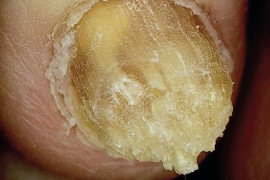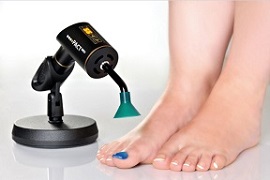Fungal Nail and Athlete's Foot

Fungal nail infection
As the name suggests fungal nail infection is caused by fungi such as dermatophytes and candida. The fungi can grow on the skin, hair, and nails, but don't invade the deeper tissues of the body. As a result of fungal infection, the nail becomes discoloured and turns white, brown, yellow or green. If not treated, gradually the nail may become thickened, brittle, flaky and loose. This could lead to other complication such as a foul smell, itch and inflammation of the area around the nail, infection of the skin and ingrown toenail. Fungi grows best in moist, dark and warm areas such as between the toes.
Some people are more susceptible to fungal infection than others for no clear reason. However, those with compromised immune system are more prone to this type of infection.
Treatment recommended for fungal nail depends on the severity of the condition and your medical history.
Oral treatment
Your GP may decide to prescribe antifungal tablets if most of your nails are affected by fungal infection. However, oral treatment might have serious side effects and tablets are only prescribed after a thorough assessment.
Topical treatment
Special paint or spray containing antifungal agents such as terbinafine is applied to the nails. Your podiatrist will also provide you with footwear and foot care advice that you need to follow in order to achieve the desired outcome. A few weeks after topical treatment begins, you will notice a band of pink and healthy nail behind the outgrowing infected nail.
Topical treatment is more effective for mild infections. For moderate to severe cases we recommend PACT.
Photodynamic antimicrobial therapy (PACT)

At Achilles Foot Clinic, we are pleased to be able to offer PACT treatment which is one of the most effective methods for treatment of fungal nail infection and kills off bacteria, fungi and viruses when applied to the nails. The treatment includes application of a dye to the nail, which makes fungal cells sensitive to light whilst having no effect on human cells. The sensitive fungal cells are then killed off when exposed to a special LED light which is completely harmless to human cells.
Athlete’s Foot (tinea pedis)

Is caused by fungal infection of the skin which may become red, itchy, scaly, dry, discoloured, cracked or blistered. Very often the infection occurs in the moist and warm areas such as in between the toes. Although, athlete’s foot is usually not serious, if left untreated, it can spread to other parts of the body or other people. Cracks caused by athlete’s foot could also act as portal of entry for bacteria which could cause bacterial infection.
Your podiatrist will explain the treatment regime that you need to follow which often involves the use of creams, sprays or liquids and following good foot hygiene. Call 01273 670 983 to book an appointment.

